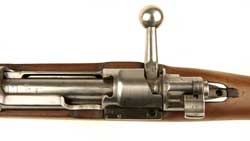
In close combat, however, submachine guns were often preferred, especially for urban combat where the rifle's range and low rate of fire were not very useful. While the Allies both Soviet and Anglo-American developed and moved towards standardization of semi-automatic rifles, the Germans maintained these bolt-action rifles due to their tactical doctrine of basing a squad's firepower on the unit's light machine gun and possibly their problems of mass producing semi-automatic rifles. Its magazine had only half the capacity of Great Britain's Lee-Enfield rifles, but being internal, it made the weapon less uncomfortable to carry. The 98k had the same disadvantages as all other turn-of-the-century military rifles in that it was comparatively bulky and heavy, and the rate of fire was limited by how fast the bolt could be operated. Plywood laminates resisted warping better than the conventional one-piece patterns, did not require lengthy maturing and were less wasteful. Most rifles had laminated stocks, the result of trials that had stretched through the s. There were also ZF 42, Zeiss Zielsechs 6x and other telescopic sights by various manufacturers with similar features employed on Karabiner 98k sniper rifles. The German Zeiss Zielvier 4x ZF39 telescopic sight had bullet drop compensation in 50 m increments for ranges from m up to m or in some variations from m up to m.


Karabiner 98k sniper rifles had an effective range up to meters yards when used by a skilled sniper. For this reason, rifles selected for being exceptionally accurate during factory tests, were also fitted with a telescopic sight as sniper rifles. The rifle was noted for its good accuracy and effective up to meters yards with iron sights. The standard Karabiner 98k iron sights could be regulated for ranges from m up to m in m increments. Since the rifle was shorter than the earlier carbines, it was given the designation Karabiner Kurz, meaning "Short Carbine Model ". It was derived from earlier rifles, namely the Karabiner 98b, which in turn had been developed from the Mauser Model The Gewehr 98 or Model took its principles from the Lebel Model rifle with the improvement of a metallic magazine of five cartridges.
#Mauser gewehr 98 icollector free#
Well, when there aren't enough criminals, one makes them.Karabiner 98 Kurz, bnz Karabiner 98k From Wikipedia, the free encyclopedia The Karabiner 98 Kurz often abbreviated Kar98k or K98k was a bolt-action rifle adopted as the standard infantry rifle in by the Wehrmacht, and was one of the final developments in the long line of Mauser military rifles.ĭescription The Karabiner 98k was a bolt-action rifle with Mauser-type action holding five rounds of 7. March 18th,PM metalman Images: They have some pretty knowledgeable people on that board and they will get you straight but they may try to buy it from you. Exceptional WWII Nazi Steyr Factory SS Contract K98 Bolt Action Rifle with SSZZA4 Markings
#Mauser gewehr 98 icollector serial#
If you had a picture of the markings and the serial I could run it by a friend who collects them. Sorry, but not every rifle with SS runes was made in some concentration camp by starving prisoners.Īctually only a very small amount of guns were actually produced there The rifles from this factory were distributed to may units so it is not really easy to tell which unit it went to.

Anyone have any other info to add? March 18th,PM boule.

It will be an easy fix and I'll have a little fun story to tell him tomorrow. The stock and bore are in very good condition. He thinks a relative brought it back from the war. I'm not a Mauser collector so I had to look them up, but it turned out to be a BNZ44 stamped receiver with numbers matching and no import marks. It turned out to be a farely bare bones german Mauser with just a few markings. He really had no idea of the history of the rifle or what was wrong with it. So a friend of mine asked me to look at an old Mauser he had that wouldn't fire.


 0 kommentar(er)
0 kommentar(er)
